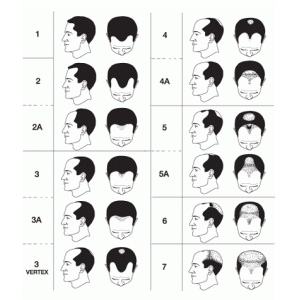 Male pattern baldness, or androgenetic alopecia, is a hereditary condition which afflicts two-thirds or men by the age of 35. By age 50, over 85 percent of men will develop signs of pattern baldness. While your genes will determine whether you are predisposed to androgenetic alopecia, other factors can contribute to the progression and degree of hair loss caused by the condition. Stress, poor diet, certain medications and treatments, and trauma are all non-genetic issues which can further weaken or destroy already vulnerable follicles. So too can the air pollution that surrounds all of us.
Male pattern baldness, or androgenetic alopecia, is a hereditary condition which afflicts two-thirds or men by the age of 35. By age 50, over 85 percent of men will develop signs of pattern baldness. While your genes will determine whether you are predisposed to androgenetic alopecia, other factors can contribute to the progression and degree of hair loss caused by the condition. Stress, poor diet, certain medications and treatments, and trauma are all non-genetic issues which can further weaken or destroy already vulnerable follicles. So too can the air pollution that surrounds all of us.
Air pollution is the source of a range of health problems, such as respiratory ailments, sinus issues, and allergies. The toxins in the air caused by industry, cars, fossil fuels, and other human activity shorten life spans and add billions of dollars to health care costs. Those same toxins that wreak havoc by entering the body and bloodstream can also cause harm when they come into contact with our skin, including our scalp and hair.
Large suspended particles, small airborne particles, smoke and gaseous pollution settle on the scalp and hair where they can cause scalp irritation, redness, itching, excessive sebum secretion, and dandruff. Those pollutants can also damage hair follicles themselves, leading to hair loss. This irritation and damage can both mimic the symptoms of and contribute to androgenetic alopecia.
Studies have shown that various toxins, chemicals and carcinogens found in polluted air (and tobacco smoke) can hurt keratins, which are the proteins that form the foundation of hair structure. When keratins are damaged, hair can become weak and brittle, causing hair growth to slow down and eventually compromising the follicles so much that they die and fall out.
Men with androgenetic alopecia can’t change their genes, and most folks can’t easily change where they live or work or reduce the amount of air pollution in their environment on their own (except for quitting smoking). However, there are plenty of ways you can strengthen and protect your hair and maintain your scalp for optimal hair growth.
You Don’t Have to Live with Male Pattern Baldness. Call the Hair Transplant Institute of Miami Today.
If male pattern baldness continues to progress, as it most often does, the Hair Transplant Institute of Miami offers a range of effective surgical and non-surgical treatment options that can put the brakes on hair loss and restore a natural-looking, full head of hair.
To learn more about the Hair Transplant Institute of Miami and how we can help you with your hair loss issues and concerns, schedule a hair loss evaluation today by contacting our clinic at 305-925-0222.

